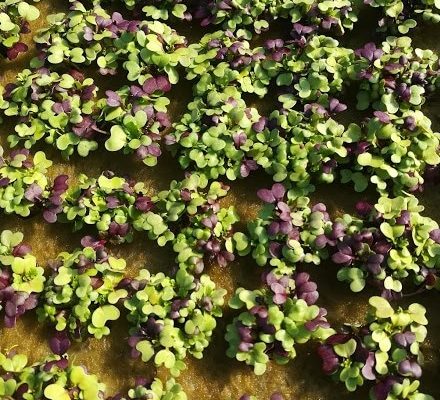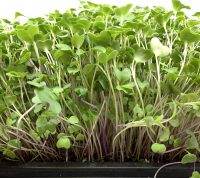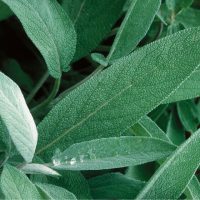A flavorful and colorful combination of microgreens that grow well together. Crunchy, nutty, fresh flavor. Nice flavor combination with a nice spicy kick.
Contains: Broccoli, Kale, Kohlrabi, Arugula, Red Cabbage & Southern Giant Mustard for an extra kick.
What is a microgreen?
Microgreens are a vegetable green, harvested after sprouting as shoots, that are used both as a visual and flavor component or ingredient primarily in fine dining restaurants. Fine dining chefs use microgreens to enhance the attractiveness and taste of their dishes with their delicate textures and distinctive flavors. Smaller than “baby greens,” and harvested later than sprouts, microgreens can provide a variety of leaf flavors, such as sweet and spicy. They are also known for their various colors and textures. Among upscale markets, they are now considered a specialty genre of greens that are good for garnishing salads, soups, plates, and sandwiches.
Edible young greens and grains are produced from various kinds of vegetables, herbs or other plants. They range in size from 1 to 3 inches (2.5 to 7.6 cm), including the stem and leaves. A microgreen has a single central stem which has been cut just above the soil line during harvesting. It has fully developed cotyledon leaves and usually has one pair of very small, partially developed true leaves. The average crop-time for most microgreens is 10–14 days from seeding to harvest.
Researchers at the USDA Agricultural Research Service have published, as of early 2014, several studies that identify the nutritional make-up and the shelf life of microgreens. Twenty-five varieties were tested, key nutrients measured were ascorbic acid (vitamin C), tocopherols (vitamin E), phylloquinone (vitamin K), and beta-carotene (a vitamin A precursor), plus other related carotenoids in the cotyledons.
Among the 25 microgreens tested, red cabbage, cilantro, garnet amaranth, and green daikon radish had the highest concentrations of vitamin C, carotenoids, vitamin K, and vitamin E, respectively. In general, microgreens contained considerably higher levels of vitamins and carotenoids—about five times greater—than their mature plant counterparts, an indication that microgreens may be worth the trouble of delivering them fresh during their short lives.
~ from Wikipedia








